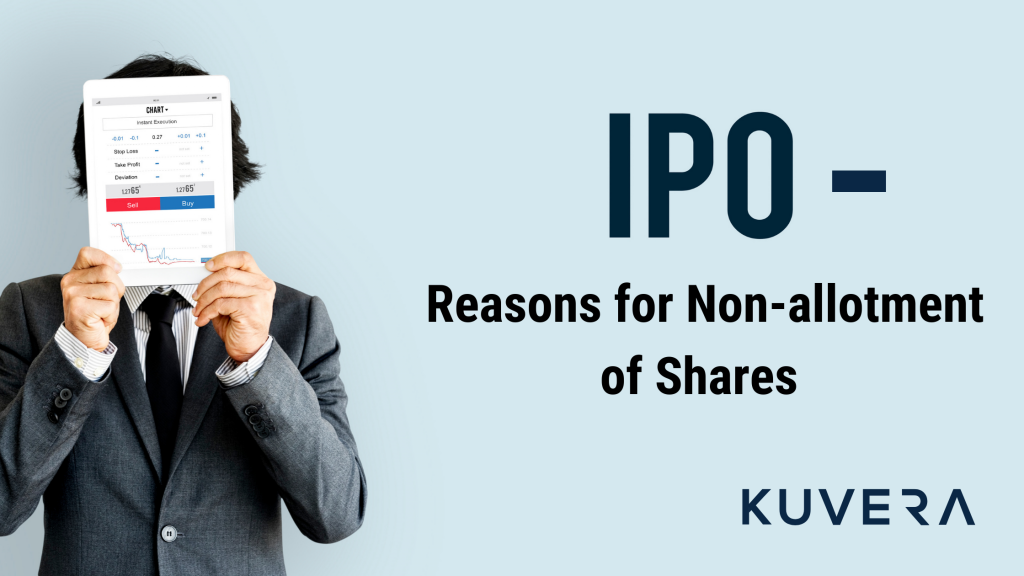Piyush and Rajiv applied for an initial public offering together. Rajiv was allotted his desired number of shares, but Piyush was not. IPO allotment depends on the number and type of responses from investors. The allotment is subject to under-subscription or oversubscription of an IPO through a randomized and computerized process.
Before explaining how companies allot shares, it is crucial to understand lot sizes.
What is Lot Size?
Lots refer to the individual divisions of a company’s total equity shares. Investors cannot buy individual shares when subscribing to an IPO; they can buy lots containing specific amounts of shares.
Thus, Number of lots = Total Number of shares / Number of shares in one lot.
For example, Company Z plans to issue 10 lakh shares via an initial public offering with ten shares. As per this equation, number of lots equal 10,00,000/10 i.e. 1,00,000.
Keep in mind that lot size will be valid only if it’s a positive integer.
Steps Involved in an Initial Public Offering Process
An IPO involves multiple steps. To subscribe to a public issue, investors must have a valid Demat/trading account. Before beginning the bidding process, investors must have a blocked account. According to SEBI, the bidding process cannot start with insufficient funds, and companies might reject such bids straightaway.
-
Allotment of lots:
Factors that affect the allotment of lots to individual traders are the number of bids, the total number of lots, and bid validity. Usually, there is an excess demand for lots if the company’s financial performance is decent enough to appeal to investors.
-
Bid approval:
Bid results generally surface in a week whereby IPO registrars announce confirmed allotments to successful bidders. Investors can check their IPO allotment status online by issuing their PAN/Client number/bid allocation number.
Share Allotment Dynamics
The initial public offering involves the allotment of shares to valid bidders. Suppose the total worth of shares of an individual bidder is greater than Rs. 2 lakh, and their status changes to the high net-worth individual. Otherwise, his status remains as an individual retail investor.
Allotment confirmation for retail investors depends on two key variables: the total number of successful bids and the total number of offered lots.
Case 1: If the total number of cumulative lot bids is less than the number of offered lots, all the bidders get fully allotted shares.
Case 2: SEBI makes sure that none of the investors receives less than one lot. In this case of over-subscription, there are two more cases that investors can face. Investors are allotted one lot for smaller over-subscriptions, and the rest is proportionately allotted.
However, the allotment registrar follows an impartial distribution system for larger over-subscriptions. The allotment system is randomized such that every investor has an equal probability of obtaining one lot.
Case 3: Certain investors (arbitrageurs) attempt to profit from market inefficiencies. Arbitrageurs have a higher risk appetite and should be able to offer attention to detail.
Furthermore, allotment cannot be pre-determined until the IPO closes. Shares are primarily distributed in Demat accounts and are not available in physical form.
Trading on the stock exchange is usually possible after two weeks of IPO closure.
Why One May Not Get Allotment?
Lot allotment is subject to maintaining the basic parameters for the application. Read on to know them.
- An invalid PAN or Demat account may result in the cancellation of one’s candidature. Moreover, multiple applications from the same Demat account are liable for cancellation. However, applications from multiple Demat accounts (belonging to family or friends) are acceptable.
- Since the lot allotment is randomized in the case of many subscribers, there is an equal chance of obtaining one. So the probability of receiving a lot depends on the total number of bidders.
Final Word
The chance of receiving an initial public offering allotment of choice is subject to numerous factors. IPO allocation determines the market performance of the company issuing them. Since the financial market is volatile, it is practically impossible to determine how an investor will be chosen in case of over-subscription.
Frequently Asked Questions
-
How can retail investors obtain shares of an IPO?
Retail investors are those who bid for amounts less than Rs. 2 lakh. In the case of an initial public offering, a minimum of 35% of the public issue is reserved for retail investors. The company offering the IPO chooses the number of lots and allows investors to purchase them. A retail investor should opt for at least one lot. However, allotment of lots is subject to under or over-subscription of lots.
-
In case of over-subscription, how likely is it to obtain a lot?
When more people apply for shares in an IPO, obtaining shares is less likely. According to SEBI guidelines, there should be a minimum application amount (between Rs. 10,000 – Rs. 15,000). The number of applicants equals the total number of shares available divided by the minimum lot size. Since the list is randomized, everyone has a fair chance of receiving (or otherwise) a lot.
-
How do HNIs take part in the allotment process?
Unlike retail investors and qualified institutional investors, high net-worth individuals need not register with SEBI. Additionally, allotment for HNIs is reserved on a pro-rated basis. In the case of over-subscription, the number of shares that HNI clients receive can be calculated by dividing the number of shares applied by HNI by the number of times the HNI portion has been over-subscribed.
Interested in how we think about the markets?
Read more: Zen And The Art Of Investing
Check out all our “Investor Education Originals” videos on Youtube and get smart about investing.
Start investing through a platform that brings goal planning and investing to your fingertips. Visit Kuvera.in to discover Direct Plans and Fixed Deposits and start investing today.
#MutualFundSahiHai #KuveraSabseSahiHai #PersonalFinance #InvestorEducation

